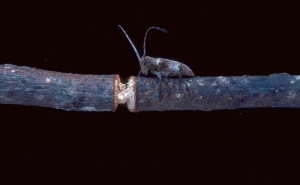Twig girdlers are gray-brown wood boring beetles with a pair of antennae that are about as long as their ¾-inch long bodies. They are active from mid-August into October when the female lays her eggs. Twig girdlers can be responsible for hanging or fallen twigs on or around a variety of trees, including hackberry poplar, linden, redbud, dogwood, and various fruit and nut trees. Heavy infestations can disfigure landscape trees.

Figure 1. Twig girdler and handiwork
Damage and Insect Development
The female twig girdler begins by chewing a deep V-shaped groove around a small twig and laying an egg in the twig beyond the cut. The girdled portion of the twig that contains the egg will soon fall to the ground. Twig girdler damage can be recognized by the smooth cut on the outside of the twig near the bark and a ragged center where the twig breaks. The larva will tunnel into the dead twig and feed until winter. Insect development will resume in spring. Ultimately, larva will pupate in the twig and emerge as an adult late in summer.
Management
Fallen twigs contain larvae of this insect so they should be collected and destroyed as soon as practical, but before early May of the following year. Hanging twigs should be pruned out and destroyed if practical. An application of Sevin at the first sign of girdling, and repeated twice at 2-week intervals, may reduce damage to infested trees. The insecticide kills the adult females before they can lay eggs but will not penetrate the twigs to kill deposited eggs or live larvae.